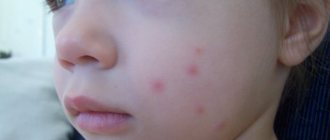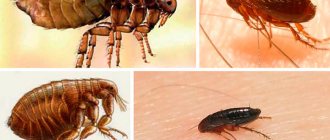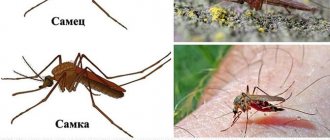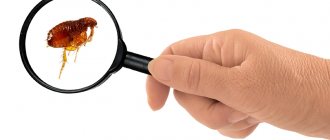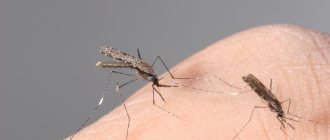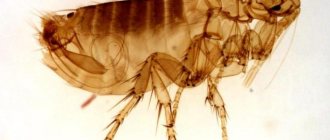Along with the appearance of pets, the question arises: will cat or dog fleas bite humans? It will be useful to know the symptoms of bites of these parasites and methods of treatment. It is also important to know what to do to protect yourself from their bites and how to kill these parasites.
Why do fleas bite?
Fortunately, humans are not suitable “housing” for fleas, because fleas need thick hair to keep them safe. It is for this reason that parasites settle on dogs, cats, and in rare cases, birds. But despite this, fleas bite both animals and people. After the parasite tastes human blood, it returns back to the pet.
The question, “Do dog or cat fleas bite humans?” directly depends on the number of parasites. In the case of a small amount, an animal is enough for them. But if fleas are not noticed in time, or ignored altogether, then their number grows, and accordingly, sooner or later, one pet will not be enough for them. That is, a person for them is just a new source of food.
How to tell if a dog has fleas
According to the experience of veterinarians, it is difficult to detect these fast parasites on a dog, although once they get on a dog, adult fleas spend 90% of their time on the body of their owner. Usually, a careful inspection will reveal only a few fleas on areas of skin with sparse fur, such as a dog's belly. You can also comb your dog with a fine comb, however, catching these insects is quite difficult.
A simple way to prove a flea infestation on a dog is to use a wet paper test to detect their feces. To do this, the dog is placed on damp white paper or cloth and combed with a comb. The appearance of black grains on the paper, giving a brown-red halo around, confirms the presence of fleas.
Since allergies to flea saliva often develop, even a single flea bite can cause debilitating itching in a dog, while the parasites themselves may not be visible. In this case, antiparasitic treatment is carried out using a flea remedy for dogs for diagnostic and therapeutic purposes.
Flea bites
It is important to know that fleas are blood-sucking insects. Their size is about 5 millimeters (it is very rare to find larger ones). They are distinguished by their jumping ability, the jump height is up to 30 centimeters.
Let's take cat fleas for consideration. They feed exclusively on blood. They have either a proboscis or a long jaw. The parasite pierces the skin until it reaches a capillary, then sucks out the blood. If the capillary is located far away, the flea can penetrate the wound up to the middle of its body.
The bite of these parasites can be felt immediately, since they do not bite like most bloodsuckers. The peculiarity of their bite is that they do not inject an anesthetic substance, so you will feel pain during the bite.
Fleas bite only those parts of the body that they can reach. The impact falls mainly on the feet and legs. But if a person was on the floor, then the flea can bite the body and arms. In children, bites can be seen everywhere.
A flea bite appears as a red spot with a dot in the center. Their arrangement is quite inconsistent. And the number of wounds directly depends on the number of fleas. It is worth noting that the saliva of these parasites causes severe itching or an allergic reaction.
Why are they dangerous?
Fleas cause the development of pulicosis and sarcopsillosis. Pustules, ulcers, and if left untreated, blisters appear. Moreover, parasites cause and transmit such dangerous diseases as:
- hepatitis B and C;
- myxomatosis;
- encephalitis;
- fibroma of rabbits.
When a person scratches a wound, he opens the door to infectious diseases. Some people are allergic to flea bites, which in severe cases can lead to anaphylactic shock.
Are flea bites dangerous to people?
Everything directly depends on the type of flea; based on this, the degree of threat can be determined. For example, cat and dog fleas rarely spread any infection. The consequences of their bites are only spots that bring discomfort in the form of itching. The only complication can only occur in case of strong scratching and ignoring hygiene.
But in exceptional cases, a complicated allergic reaction may develop in the form of swelling, severe and regular itching, and, accordingly, redness.
And in the case of a collision with rodent parasites, everything is much more complicated, because they carry diseases such as plague, typhoid, anthrax and tularemia.
Flea treatment for dogs
How to get rid of fleas on a dog?
Once faced with a flea problem, owners hope to find the best flea treatment for dogs.
It is preferable to use drugs that, when applied to the dog’s skin, also help treat the environment and kill the flea population. What flea treatment for dogs has this “umbrella effect”? Such drugs include Stronghold in the form of drops on the withers. The drug is applied to intact dry skin at the base of the neck in a dose corresponding to the instructions for the weight of the animal every month. The drug is quickly absorbed from the skin, bathing with shampoo does not reduce its effectiveness, so the dog can be washed with shampoo within a couple of hours after applying Stronghold. The drug is not recommended for use in puppies under 6 weeks of age if the dog is hypersensitive to Stronghold. Treatment of pregnant and lactating females with Stronghold is permitted, but it is recommended that it be carried out under the supervision of a veterinarian.
Many, even experienced dog owners who regularly use the same flea and tick treatment for dogs, may encounter the problem of flea infestation in their dog, despite the treatment. Why is this happening? In some cases, the ineffectiveness of flea treatment is associated with an insufficient dose of the drug. Flea and tick medications for dogs should be used as directed. This is especially important to consider when treating puppies, whose weight can double during the period of action of the drug. Therefore, when treating puppies for fleas, it is recommended to use a drug that has low toxicity, the dose of which can be calculated based on the weight of the puppy by the end of the effect of the drug against fleas and ticks for dogs. Another reason for ineffectiveness of drop treatments is incorrect application of the drug. Most topical products spread over the dog's skin; running spot-on through the coat is ineffective. In addition, a product that has proven to be an effective flea treatment for dogs for many years may become resistant to fleas after some time.
Simparika, produced in tablets, which is an active drug against fleas and ticks, will help solve the above issues. The drug is quickly absorbed from the gastrointestinal tract and is low-hazard in terms of the degree of impact on the dog’s body. The drug is in the blood in a protein-bound state at a therapeutic concentration for 35 days. Bathing your dog with shampoo does not affect its activity against fleas and ticks. Contraindications are increased individual sensitivity to the components of the drug, age under 8 weeks, as well as severe renal and liver dysfunction and infectious diseases. As a rule, dogs voluntarily eat the tablet, since it has a liver taste that is attractive to the dog; eating the food does not affect the absorption of the drug.
Destruction of fleas in Pokrov
Finding these parasites is not difficult. But after you already know that they live with you, the question arises - “what to do next?” First of all, examine the pets and carry out a special treatment with insecticidal drops, lotions or sprays; you can wash the animal with a special shampoo. There are many different products that can be purchased at a veterinary store.
At the same time, you need to destroy fleas in the apartment itself. They, like many parasites, can hide in various crevices, furniture that has pile, carpets, etc. Fleas will not live long in an open environment because they need regular food. But if you ignore the “cleaning” of the apartment, you can give your pet a chance to become infected again.
There is the following sequence of actions after detecting parasites in an apartment:
- Carry out a wet general cleaning of the apartment;
- Wash everything possible (clothes, curtains, carpets, etc.)
- Treating all cracks, walls, furniture with a special product;
- Ventilate the room well.
But you need to know that complete treatment and cleaning does not protect you from the return of parasites. Especially if your pet loves to go outside. In this case, it is recommended to purchase a special collar - it has the property of repelling these parasites. Or you can use special drops (for example, Bars). Also, do not allow such pets into your bed.
In case of severe infection of the apartment, it is best to call the SES service. The sanitary and epidemiological station will destroy fleas much faster and you won’t have to rack your brains. SES employees offer comprehensive services for the destruction of parasites. You can call the housing maintenance office (ZhEK) to call the SES in Pokrov.
Bed fleas: where do they come from?
If bed fleas appear in an apartment, the first question that arises among household members is: “Where do ectoparasites come from, and how to quickly get rid of them?” The effectiveness of the fight depends not only on the methods chosen, but also on how quickly the owners treated the premises. The sooner the fight against fleas begins, the higher the likelihood of a successful outcome. Fleas have a high reproduction rate, so even if single individuals are detected, you should immediately begin preparations for their destruction.
Most often, fleas appear in apartments with pets. They can get caught in the fur of a cat or dog while walking and interacting with other animals. Therefore, it is important to periodically treat pets with special veterinary medications and protect them with flea collars and shampoo. It is possible that household members themselves bring ectoparasite eggs with shoes or clothes.
Ground fleas prefer to make nests in the basement. But in search of food, they climb into apartments on the 1st and 2nd floors, where they drink the blood of a person or animal and return back. A sharp change in microclimate can force them to change their comfortable habitat.
How do fleas appear in private homes? Their carriers can be not only pets, but also rodents (mice, rats) living in the attic, barn, basement and other technical structures.
Prevention from bites in Pokrov
Based on what we have read, we conclude that fleas do bite people. And every pet owner must follow the rules of prevention, namely:
- Regular examination of your pet;
- If necessary, carry out special processing;
- For every pet walk, use flea-repellent collars or other special means;
In order to protect yourself from flea bites, it is enough to wear covered clothing and use parasite repellents. Also, if there are fleas in the house, do not let the kids crawl on the floor.
Strong-smelling essential oils and plants (mint, wormwood) can also help repel parasites. Essential oils can be added to a bucket of water for cleaning floors, such as geranium. This will prevent parasites from entering the apartment.
Which species bite?
Fleas and their bites
Animal fleas bite people so as not to die of hunger. However, in this case they are not able to continue normal life activities. Preference is still given to cats, dogs, or rats and mice.
Dog fleas bite people much less often. The most annoying and annoying are the ectoparasites of cats. Cat fleas can bite humans with extreme regularity. They calmly jump from an animal to a human body, and back.
On a note!
The question of which fleas bite people can be answered with everything. Pets become infected from wild animals, yard “residents”, rats, mice. They bring it to the house. There, adults leave eggs, the larvae go through all stages of development within 20 days, and the apartment becomes infected.
Do cat fleas bite people, the answer is yes. Why fleas bite humans is also clear. But there are situations when parasites attack one owner of the house, while others do not suffer from bites. This species parasitizes rats and mice, so their attack is dangerous due to the introduction of infection and helminth eggs.
Treatment methods for bites
If you are bitten by a cat or dog flea, the wound can be treated with any antiseptic (for example, hydrogen peroxide).
If the bite is very itchy, then you need to treat the surface of the skin at the site of the bite with a soothing antihistamine gel and take 1 tablet of Suprastin. Don’t immediately panic and call an ambulance. Medical attention is only needed if a severe allergic reaction develops.
You can also use folk remedies; for disinfection, you can use tea tree oil or a compress of potato juice.
